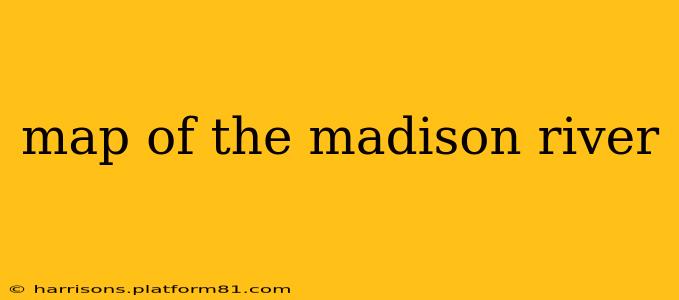The Madison River, a renowned blue-ribbon trout stream, cuts a picturesque path through southwest Montana, captivating anglers and outdoor enthusiasts alike. Its pristine waters, challenging rapids, and abundant wildlife make it a truly exceptional destination. This guide provides a detailed overview of the river, addressing frequently asked questions and offering insights for your next adventure. We'll explore its various sections, highlighting key features and providing a helpful understanding of its geography. While we cannot provide a directly downloadable map here, readily available online resources (like Google Maps, dedicated fishing maps, or Montana state park websites) offer detailed cartographic representations.
What are the different sections of the Madison River?
The Madison River can be broadly divided into several distinct sections, each offering a unique fishing experience and character:
-
Upper Madison: This section, originating from Hebgen Lake, is characterized by its calmer waters and slower pace. It’s known for its dry fly fishing opportunities and abundant populations of trout. Access points are generally less frequent than further downstream.
-
Middle Madison: The Middle Madison is arguably the most popular section, boasting a mix of riffles, runs, and pools. It offers a diverse range of fishing techniques, from nymphing to streamer fishing, catering to both beginner and experienced anglers. Access is easier here, with numerous public and private access points.
-
Lower Madison: This section of the river flows through a wider valley, featuring slower currents and larger pools. It's known for its consistent fishing, especially during the warmer months. The river becomes significantly wider here, changing its character noticeably from the upper and middle reaches.
Where is the Madison River located?
The Madison River flows through southwest Montana, originating in Yellowstone National Park and eventually joining the Jefferson and Gallatin rivers to form the Missouri River. Its geographic location significantly influences its water temperature and fishing conditions throughout the year.
What kind of fish are in the Madison River?
The Madison River is famous for its robust trout population. Rainbow trout are the most common, but you can also find brown trout and cutthroat trout. The size and abundance of these fish vary depending on the specific section of the river and the time of year. The river also supports other fish species, although trout are the main attraction for anglers.
What is the best time of year to fish the Madison River?
The best time to fish the Madison River depends on your preferred fishing techniques and the species you are targeting. Generally, the summer months (June-September) offer excellent dry fly fishing opportunities, while the spring and fall are ideal for nymphing and streamer fishing. Water levels and temperatures fluctuate throughout the year, influencing fishing conditions. Checking river flow reports before heading out is always a good idea.
How difficult is it to fish the Madison River?
The difficulty of fishing the Madison River varies depending on the section and your experience level. The Upper Madison is generally easier to navigate and fish, while the Middle and Lower Madison can present more challenges, particularly in higher water conditions. Regardless of your experience, respect the river and its surroundings; always practice responsible angling techniques.
What are the regulations for fishing on the Madison River?
Fishing regulations on the Madison River are established and enforced by the Montana Fish, Wildlife & Parks (FWP). These regulations include catch limits, size restrictions, and gear restrictions. It is crucial to familiarize yourself with the current regulations before fishing to ensure compliance and protect this valuable resource. You can find the most up-to-date information on the FWP website. (Note: I cannot provide direct links to external websites.)
This guide offers a starting point for understanding and exploring the Madison River. Remember to consult official resources for the most current and accurate information on maps, regulations, and access points to ensure a safe and enjoyable experience. Remember to always practice Leave No Trace principles and respect the environment.
